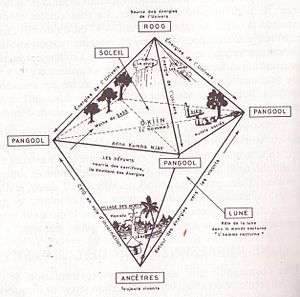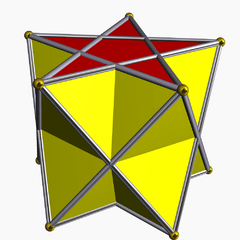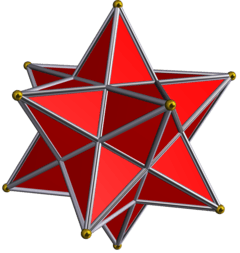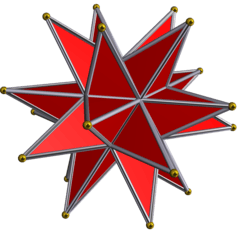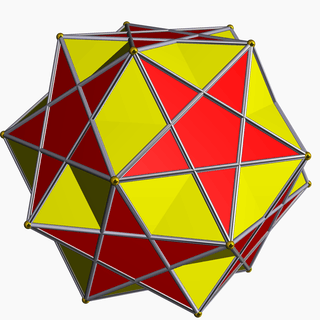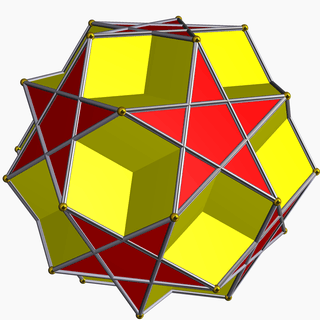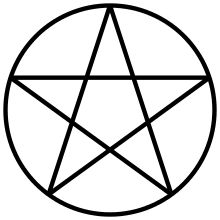Pentagram
A pentagram (sometimes known as a pentalpha, pentangle or star pentagon) is the shape of a five-pointed star polygon.
| Regular pentagram | |
|---|---|
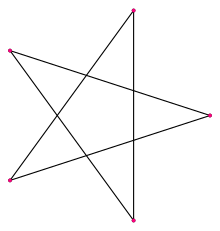 A regular pentagram | |
| Type | Regular star polygon |
| Edges and vertices | 5 |
| Schläfli symbol | {5/2} |
| Coxeter diagram | |
| Symmetry group | Dihedral (D5) |
| Internal angle (degrees) | 36° |
| Dual polygon | self |
| Properties | Star, cyclic, equilateral, isogonal, isotoxal |
| Star polygons |
|---|
|
|
Pentagrams were used symbolically in ancient Greece and Babylonia, and are used today as a symbol of faith by many Wiccans, akin to the use of the cross by Christians. The pentagram has magical associations. Many people who practice Neopagan faiths wear jewelry incorporating the symbol. Christians once commonly used the pentagram to represent the five wounds of Jesus.[1][2] The pentagram is also used as a symbol by other belief systems and is associated with Freemasonry.
The word pentagram comes from the Greek word πεντάγραμμον (pentagrammon),[3] from πέντε (pente), "five" + γραμμή (grammē), "line".[4] The word "pentacle" is sometimes used synonymously with "pentagram".[5] The word pentalpha is a learned modern (17th-century) revival of a post-classical Greek name of the shape.[6]
History
Early history
In early (Ur I) monumental Sumerian script, or cuneiform, a pentagram glyph served as a logogram for the word ub, meaning "corner, angle, nook; a small room, cavity, hole; pitfall" (this later gave rise to the cuneiform sign UB 𒌒, composed of five wedges, further reduced to four in Assyrian cuneiform).
The word Pentemychos (πεντέμυχος lit. "five corners" or "five recesses")[7] was the title of the cosmogony of Pherecydes of Syros.[8] Here, the "five corners" are where the seeds of Chronos are placed within the Earth in order for the cosmos to appear.[9]
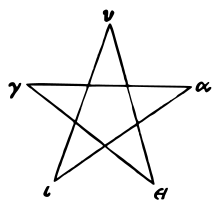
In Neoplatonism, the pentagram was said to have been used as a symbol or sign of recognition by the Pythagoreans, who called the pentagram ὑγιεία hugieia "health"[11]
Western symbolism
The pentagram was used in ancient times as a Christian symbol for the five senses,[12] or of the five wounds of Christ. The pentagram plays an important symbolic role in the 14th-century English poem Sir Gawain and the Green Knight, in which the symbol decorates the shield of the hero, Gawain. The unnamed poet credits the symbol's origin to King Solomon, and explains that each of the five interconnected points represents a virtue tied to a group of five: Gawain is perfect in his five senses and five fingers, faithful to the Five Wounds of Christ, takes courage from the five joys that Mary had of Jesus, and exemplifies the five virtues of knighthood.[13]
Heinrich Cornelius Agrippa and others perpetuated the popularity of the pentagram as a magic symbol, attributing the five neoplatonic elements to the five points, in typical Renaissance fashion. By the mid-19th century a further distinction had developed amongst occultists regarding the pentagram's orientation. With a single point upwards it depicted spirit presiding over the four elements of matter, and was essentially "good". However, the influential writer Éliphas Lévi called it evil whenever the symbol appeared the other way up.
- "A reversed pentagram, with two points projecting upwards, is a symbol of evil and attracts sinister forces because it overturns the proper order of things and demonstrates the triumph of matter over spirit. It is the goat of lust attacking the heavens with its horns, a sign execrated by initiates."[14]
- "The flaming star, which, when turned upside down, is the hierolgyphic [sic] sign of the goat of black magic, whose head may be drawn in the star, the two horns at the top, the ears to the right and left, the beard at the bottom. It is the sign of antagonism and fatality. It is the goat of lust attacking the heavens with its horns."[15]
- "Let us keep the figure of the Five-pointed Star always upright, with the topmost triangle pointing to heaven, for it is the seat of wisdom, and if the figure is reversed, perversion and evil will be the result."[16]
.jpg) Man inscribed in a pentagram, from Heinrich Cornelius Agrippa's De occulta philosophia libri tres. The five signs at the pentagram's vertices are astrological.
Man inscribed in a pentagram, from Heinrich Cornelius Agrippa's De occulta philosophia libri tres. The five signs at the pentagram's vertices are astrological.- Another pentagram from Agrippa's book. This one has the Pythagorean letters inscribed around the circle.
.jpg) The occultist and magician Éliphas Lévi's pentagram, which he considered to be a symbol of the microcosm, or human.
The occultist and magician Éliphas Lévi's pentagram, which he considered to be a symbol of the microcosm, or human.
The apotropaic use of the pentagram symbol in German folklore (called Drudenfuss in German) is referred to by Goethe in Faust (1808), where a pentagram prevents Mephistopheles from leaving a room (but did not prevent him from entering by the same way, as the outward pointing corner of the diagram happened to be imperfectly drawn):
- Mephistopheles:
- I must confess, my stepping o'er
- Thy threshold a slight hindrance doth impede;
- The wizard-foot [Drudenfuss] doth me retain.
- Faust:
- The pentagram thy peace doth mar?
- To me, thou son of hell, explain,
- How camest thou in, if this thine exit bar?
- Could such a spirit aught ensnare?
- Mephistopheles:
- Observe it well, it is not drawn with care,
- One of the angles, that which points without,
- Is, as thou seest, not quite closed.
East Asian symbolism
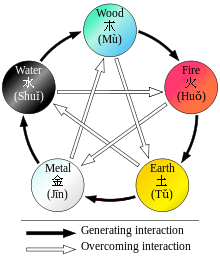
Wu Xing (Chinese: 五行; pinyin: Wǔ Xíng) are the five phases, or five elements in Chinese tradition. They are similar to the ancient Greek elements, with more emphasis on their cyclic transformation than on their material aspects. The five phases are: Fire (火 huǒ), Earth (土 tǔ), Metal (金 jīn), Water (水 shuǐ), and Wood (木 mù).
Uses in modern occultism
Based on Renaissance-era occultism, the pentagram found its way into the symbolism of modern occultists. Its major use is a continuation of the ancient Babylonian use of the pentagram as an apotropaic charm to protect against evil forces.[17] Éliphas Lévi claimed that "The Pentagram expresses the mind's domination over the elements and it is by this sign that we bind the demons of the air, the spirits of fire, the spectres of water, and the ghosts of earth."[18] In this spirit, the Hermetic Order of the Golden Dawn developed the use of the pentagram in the lesser banishing ritual of the pentagram, which is still used to this day by those who practice Golden Dawn-type magic.
Aleister Crowley made use of the pentagram in his Thelemic system of magick: an adverse or inverted pentagram represents the descent of spirit into matter, according to the interpretation of Lon Milo DuQuette.[19] Crowley contradicted his old comrades in the Hermetic Order of the Golden Dawn, who, following Levi, considered this orientation of the symbol evil and associated it with the triumph of matter over spirit.
Use in new religious movements
Bahá'í
The five-pointed star is a symbol of the Bahá'í Faith.[20][21] In the Bahá'í Faith, the star is known as the Haykal (Arabic: "temple"), and it was initiated and established by the Báb. The Báb and Bahá'u'lláh wrote various works in the form of a pentagram.[22][23]
 Haykal by the Báb written in his own hand.
Haykal by the Báb written in his own hand.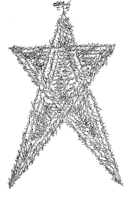 An unidentified work of the Báb.
An unidentified work of the Báb.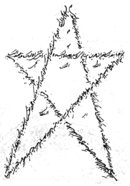 An unidentified work of the Báb.
An unidentified work of the Báb.
The Church of Jesus Christ of Latter-day Saints
The Church of Jesus Christ of Latter-day Saints is theorized to have began using both upright and inverted five-pointed stars in Temple architecture, dating from the Nauvoo Illinois Temple dedicated on 30 April 1846.[24] Other temples decorated with five-pointed stars in both orientations include the Salt Lake Temple and the Logan Utah Temple. These usages come from the symbolism found in Revelation chapter 12: "And there appeared a great wonder in heaven; a woman clothed with the sun, and the moon under her feet, and upon her head a crown of twelve stars."[25]
Wicca
Because of a perceived association with Satanism and occultism, many United States schools in the late 1990s sought to prevent students from displaying the pentagram on clothing or jewelry.[26] In public schools, such actions by administrators were determined in 2000 to be in violation of students' First Amendment right to free exercise of religion.[27]
The encircled pentagram (referred to as a pentacle by the plaintiffs) was added to the list of 38 approved religious symbols to be placed on the tombstones of fallen service members at Arlington National Cemetery on 24 April 2007. The decision was made following ten applications from families of fallen soldiers who practiced Wicca. The government paid the families US$225,000 to settle their pending lawsuits.[28][29]
Other religious use
Serer religion
The five-pointed star is a symbol of the Serer religion and the Serer people of West Africa. Called Yoonir in their language, it symbolizes the universe in the Serer creation myth, and also represents the star Sirius.[30][31]
Druze
A multicolored version is used as symbol of the Druze religion.
Other modern use
- The pentagram is featured on the national flags of Morocco (adopted 1915) and Ethiopia (adopted 1996 and readopted 2009)
- The Order of the Eastern Star, an organization (established 1850) associated with Freemasonry, uses a pentagram as its symbol, with the five isosceles triangles of the points colored blue, yellow, white, green, and red. In most Grand Chapters the pentagram is used point down, but in a few it is point up. Grand Chapter officers often have a pentagon inscribed around the star[33](the emblem shown here is from the Prince Hall Association).
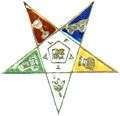 Order of the Eastern Star emblem
Order of the Eastern Star emblem
- A pentagram is featured on the flag of the Dutch city of Haaksbergen, as well on its coat of arms.
 Flag of Haaksbergen
Flag of Haaksbergen
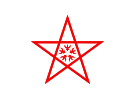 Flag of Nagasaki
Flag of Nagasaki
Geometry
The pentagram is the simplest regular star polygon. The pentagram contains ten points (the five points of the star, and the five vertices of the inner pentagon) and fifteen line segments. It is represented by the Schläfli symbol {5/2}. Like a regular pentagon, and a regular pentagon with a pentagram constructed inside it, the regular pentagram has as its symmetry group the dihedral group of order 10.
It can be seen as a net of a pentagonal pyramid although with isosceles triangles.
Construction
The pentagram can be constructed by connecting alternate vertices of a pentagon; see details of the construction. It can also be constructed as a stellation of a pentagon, by extending the edges of a pentagon until the lines intersect.
Truncation
A uniform truncated pentagram t{5/2} produces a doubly-wrapped pentagon with overlapping vertices and edges, {10/2}. A shallower truncation produces an isogonal figure, like this one with equally spaced vertices. A truncated retro-pentagram t{5/3}, or a quasitruncation, produces a decagram, {10/3}.
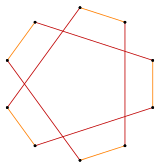 shallow t{5/2} |
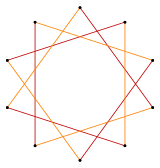 t{5/3} = {10/3} |
Golden ratio

The golden ratio, φ = (1 + √5) / 2 ≈ 1.618, satisfying
plays an important role in regular pentagons and pentagrams. Each intersection of edges sections the edges in the golden ratio: the ratio of the length of the edge to the longer segment is φ, as is the length of the longer segment to the shorter. Also, the ratio of the length of the shorter segment to the segment bounded by the two intersecting edges (a side of the pentagon in the pentagram's center) is φ. As the four-color illustration shows:
The pentagram includes ten isosceles triangles: five acute and five obtuse isosceles triangles. In all of them, the ratio of the longer side to the shorter side is φ. The acute triangles are golden triangles. The obtuse isosceles triangle highlighted via the colored lines in the illustration is a golden gnomon.
Trigonometric values
As a result, in an isosceles triangle with one or two angles of 36°, the longer of the two side lengths is φ times that of the shorter of the two, both in the case of the acute as in the case of the obtuse triangle.
Spherical pentagram
A pentagram can be drawn as a star polygon on a sphere, composed of five great circle arcs, whose all internal angles are right angles. This shape was described by John Napier in his 1614 book Mirifici logarithmorum canonis descriptio (Description of the wonderful rule of logarithms) along with rules that link the values of trigonometric functions of five parts of a right spherical triangle (two angles and three sides). It was studied later by Carl Friedrich Gauss.
Higher dimensions
Orthogonal projections of higher dimensional polytopes can also create pentagrammic figures:
| 4D | 5D | ||
|---|---|---|---|
 The regular 5-cell (4-simplex) has five vertices and 10 edges. |
 The rectified 5-cell has 10 vertices and 30 edges. |
 The rectified 5-simplex has 15 vertices, seen in this orthogonal projection as three nested pentagrams. |
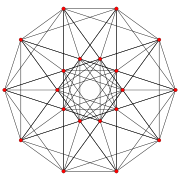 The birectified 5-simplex has 20 vertices, seen in this orthogonal projection as four overlapping pentagrams. |
All ten 4-dimensional Schläfli–Hess 4-polytopes have either pentagrammic faces or vertex figure elements.
Pentagram of Venus
.svg.png)
The pentagram of Venus is the apparent path of the planet Venus as observed from Earth. Successive inferior conjunctions of Venus repeat with an orbital resonance of approximately 13:8—that is, Venus orbits the Sun approximately 13 times for every eight orbits of Earth—shifting 144° at each inferior conjunction.[34] The tips of the five loops at the center of the figure have the same geometric relationship to one another as the five vertices, or points, of a pentagram, and each group of five intersections equidistant from the figure's center have the same geometric relationship.
See also
References
- Becker, Udo (1994). "Pentagram". The Continuum Encyclopedia of Symbols. Translated by Garmer, Lance W. Continuum. p. 230. ISBN 978-0-8264-1221-8.
- Ferguson, George Wells (1966). Signs & Symbols in Christian Art. Oxford University Press. p. 59. ISBN 978-0-19-501432-7.
- πεντάγραμμον, Henry George Liddell, Robert Scott, A Greek-English Lexicon, on Perseus; a noun form of adjectival πεντάγραμμος (pentagrammos) or πεντέγραμμος (pentegrammos), a word meaning roughly "five-lined" or "five lines"
- πέντε, Henry George Liddell, Robert Scott, A Greek-English Lexicon, on Perseus; γραμμή, Henry George Liddell, Robert Scott, A Greek-English Lexicon, on Perseus
- this usage is borne out by the Oxford English Dictionary, although that work specifies that a circumscription makes the sthe form of a five-pointed star and its etymon post-classical Latin pentaculum [...] A pentagram, esp. one enclosed in a circle; a talisman or magical symbol in the shape of or inscribed with a pentagram. Also, in extended use: any similar magical symbol (freq. applied to a hexagram formed by two intersecting or interlaced equilateral triangles)."
- πένταλϕα, "five Alphas", interpreting the shape as five Α shapes overlapping at 72-degree angles.
- πεντέμυχος, Henry George Liddell, Robert Scott, A Greek-English Lexicon, on Perseus
- This is a lost book, but its contents are preserved in Damascius, De principiis, quoted in Kirk and Raven, (1983) [1956], p. 55.
- "the divine products of Chronos' seed, when disposed in five recesses, were called πεντέμυχος (Pentemychos)" Kirk, Geoffrey Stephen; Raven, John Earle; Schofield, Malcolm (1983) [1957]. The Presocratic Philosophers: A Critical History with a Selection of Texts (2nd, illustrated, revised, reprint ed.). Cambridge University Press. pp. 51–52, 55. ISBN 978-0-521-27455-5.
the only other place in Homer where Ortygie [sic] is mentioned is Odyssey V, 123, where Orion, having been carried off by Eos [the dawn], is slain... by Artemis... since solstices would normally be observed at sunrise in summer, and so in the north-east-by-east direction, that is what the phrase might suggest... the dwelling-place of Eos... Aia..
- Allman, G. J., Greek Geometry From Thales to Euclid (1889), p.26.
- Allman, G. J., Greek Geometry From Thales to Euclid, part I (1877), in Hermathena 3.5, pp. 183, 197, citing Iamblichus and the Scholiast on Aristophanes. The pentagram was said to have been so called from Pythagoras himself having written the letters Υ, Γ, Ι, Θ (= /ei/), Α on its vertices.
- Christian Symbols Ancient and Modern, Child, Heather and Dorothy Colles. New York: Charles Scribner's Sons, 1971, ISBN 0-7135-1960-6.
- Morgan, Gerald (1979). "The Significance of the Pentangle Symbolism in "Sir Gawain and the Green Knight"". The Modern Language Review. 74 (4): 769–790. JSTOR 3728227.
- Lévi, Éliphas (1999) [1896 (translated), 1854 (first published)]. Transcendental Magic, its Doctrine and Ritual [Dogme et rituel de la haute magie]. Trans. by A. E. Waite. York Beach: Weiser. OCLC 263626874.
- Lévi, Éliphas (2002) [1939 (translated), 1859 (first published)]. The Key of the Mysteries [la Clef des grands mystères suivant Hénoch, Abraham, Hermès Trismégiste et Salomon]. Trans. by Aleister Crowley. Boston: Weiser. p. 69. OCLC 49053462.
- Hartmann, Franz (1895) [1886]. Magic, White and Black (5th ed.). New York: The Path. OCLC 476635673.
- Schouten, Jan (1968). The Pentagram as Medical Symbol: An Iconological Study. Hes & De Graaf. p. 18. ISBN 978-90-6004-166-6.
- Waite, Arthur Edward (1886). The Mysteries of Magic: A Digest of the Writings of Eliphas Lévi. London: George Redway. p. 136.
- DuQuette, Lon Milo (2003). The Magick of Aleister Crowley: A Handbook of the Rituals of Thelema. Weiser Books. pp. 93, 247. ISBN 978-1-57863-299-2.
- Bahá'í Reference Library – Directives from the Guardian, Pages 51–52
- Nine-Pointed Star, The:History and Symbolism by Universal House of Justice 24 January 1999
- Moojan Momen (2019). The Star Tablet of the Bab. British Library Blog.
- Bayat, Mohamad Ghasem (2001). An Introduction to the Súratu'l-Haykal (Discourse of The Temple) in Lights of Irfan, Book 2.
- See the Nauvoo Temple website discussing its architecture, and particularly the page on Nauvoo Temple exterior symbolism. Retrieved 16 December 2006.
- Brown, Matthew B (2002). "Inverted Stars on LDS Temples" (PDF). FAIRLDS.org. Archived from the original (PDF) on 29 February 2008.
- "Religious Clothing in School", Robinson, B.A., Ontario Consultants on Religious Tolerance, 20 August 1999, updated 29 April 2005. Retrieved 10 February 2006. "ACLU Defends Honor Student Witch Pentacle" (Press release). American Civil Liberties Union of Michigan. 10 February 1999. Archived from the original on 8 November 2003. Retrieved 10 February 2006.CS1 maint: BOT: original-url status unknown (link) "Witches and wardrobes: Boy says he was suspended from school for wearing magical symbol" Rouvalis, Cristina; Pittsburgh Post-Gazette, 27 September 2000. Retrieved 10 February 2006.
- "Federal judge upholds Indiana students' right to wear Wiccan symbols". Associated Press. 1 May 2000. Archived from the original on 30 March 2014. Retrieved 21 September 2007.CS1 maint: BOT: original-url status unknown (link)
- Associated Press (23 April 2007). "Wiccan symbol OK for soldiers' graves". CNN.com. Archived from the original on 26 April 2007.
- "Burial and Memorials: Available Emblems of Belief for Placement on Government Headstones and Markers". United States Department of Veterans Affairs. 3 July 2013. Retrieved 13 January 2014.
- Gravrand 1990, p. 20.
- Madiya, Clémentine Faïk-Nzuji (1996). Tracing Memory: A Glossery of Graphic Signs and Symbols in African Art and Culture. Mercury series, no. 71. Hull, Québec: Canadian Museum of Civilization. pp. 27, 155. ISBN 0-660-15965-1.
- Gravrand 1990, p. 216.
- Ritual of the Order of the Eastern Star, 1976
- Baez, John (4 January 2014). "The Pentagram of Venus". Azimuth. Archived from the original on 14 December 2015. Retrieved 7 January 2016.
Bibliography
- Becker, Udo (1994). "Pentagram". The Continuum Encyclopedia of Symbols. Translated by Garmer, Lance W. New York City: Continuum Books. p. 230. ISBN 978-0-8264-0644-6.CS1 maint: ref=harv (link)
- Conway, John Horton; Burgiel, Heidi; Goodman-Strauss, Chaim (April 2008). "Chapter 26, Higher Still: Regular Star-Polytopes". The Symmetries of Things. Wellesley, Massachusetts: A. K. Peters. p. 404. ISBN 978-1-56881-220-5.CS1 maint: ref=harv (link)
- Ferguson, George Wells (1966) [1954]. Signs and Symbols in Christian Art. New York City: Oxford University Press. p. 59. OCLC 65081051.CS1 maint: ref=harv (link)
- Gravrand, Henry (January 1990). La civilisation Sereer, Volume II: Pangool. Nouvelles éditions Africaines du Sénégal (in French). Dakar, Senegal. ISBN 2-7236-1055-1.CS1 maint: ref=harv (link)
- Grünbaum, Branko; Shephard, Geoffrey Colin (1987). Tilings and Patterns. New York: W. H. Freeman. ISBN 978-0-7167-1193-3.CS1 maint: ref=harv (link)
- Grünbaum, Branko (1994). "Polyhedra with Hollow Faces". In Bisztriczky, T.; McMullen, P.; Schneider, A.; Weiss, A. Ivić (eds.). Polytopes: Abstract, Convex and Computational. NATO ASI Series C: Mathematical and Physical Sciences. 440. Dordrecht: Springer Netherlands. pp. 43–70. doi:10.1007/978-94-011-0924-6_3. ISBN 978-94-010-4398-4.CS1 maint: ref=harv (link)
External links
| Wikimedia Commons has media related to Pentagrams. |
- Weisstein, Eric W. "Pentagram". MathWorld.
- The Pythagorean Pentacle from the Biblioteca Arcana.



